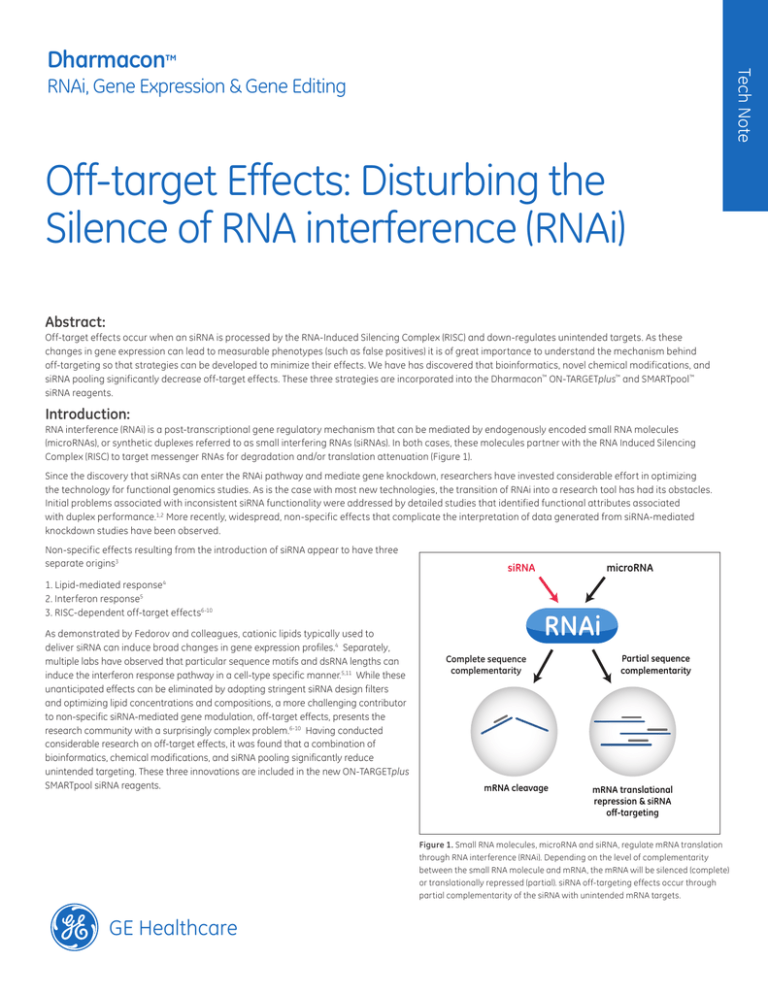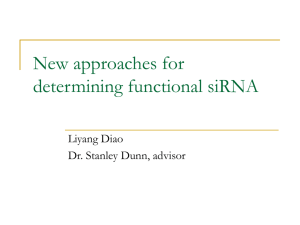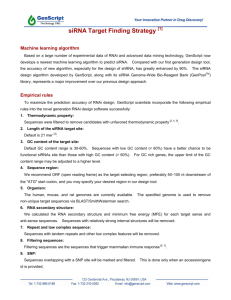
Tech Note
Dharmacon™
RNAi, Gene Expression & Gene Editing
Off-target Effects: Disturbing the
Silence of RNA interference (RNAi)
Abstract:
Off-target effects occur when an siRNA is processed by the RNA-Induced Silencing Complex (RISC) and down-regulates unintended targets. As these
changes in gene expression can lead to measurable phenotypes (such as false positives) it is of great importance to understand the mechanism behind
off-targeting so that strategies can be developed to minimize their effects. We have has discovered that bioinformatics, novel chemical modifications, and
siRNA pooling significantly decrease off-target effects. These three strategies are incorporated into the Dharmacon™ ON-TARGETplus™ and SMARTpool™
siRNA reagents.
Introduction:
RNA interference (RNAi) is a post-transcriptional gene regulatory mechanism that can be mediated by endogenously encoded small RNA molecules
(microRNAs), or synthetic duplexes referred to as small interfering RNAs (siRNAs). In both cases, these molecules partner with the RNA Induced Silencing
Complex (RISC) to target messenger RNAs for degradation and/or translation attenuation (Figure 1).
Since the discovery that siRNAs can enter the RNAi pathway and mediate gene knockdown, researchers have invested considerable effort in optimizing
the technology for functional genomics studies. As is the case with most new technologies, the transition of RNAi into a research tool has had its obstacles.
Initial problems associated with inconsistent siRNA functionality were addressed by detailed studies that identified functional attributes associated
with duplex performance.1,2 More recently, widespread, non-specific effects that complicate the interpretation of data generated from siRNA-mediated
knockdown studies have been observed.
Non-specific effects resulting from the introduction of siRNA appear to have three
separate origins3
siRNA
1. Lipid-mediated response
2. Interferon response5
3. RISC-dependent off-target effects6-10
microRNA
4
As demonstrated by Fedorov and colleagues, cationic lipids typically used to
deliver siRNA can induce broad changes in gene expression profiles.4 Separately,
multiple labs have observed that particular sequence motifs and dsRNA lengths can
induce the interferon response pathway in a cell-type specific manner.5,11 While these
unanticipated effects can be eliminated by adopting stringent siRNA design filters
and optimizing lipid concentrations and compositions, a more challenging contributor
to non-specific siRNA-mediated gene modulation, off-target effects, presents the
research community with a surprisingly complex problem.6-10 Having conducted
considerable research on off-target effects, it was found that a combination of
bioinformatics, chemical modifications, and siRNA pooling significantly reduce
unintended targeting. These three innovations are included in the new ON-TARGETplus
SMARTpool siRNA reagents.
RNAi
Complete sequence
complementarity
mRNA cleavage
Partial sequence
complementarity
mRNA translational
repression & siRNA
off-targeting
Figure 1. Small RNA molecules, microRNA and siRNA, regulate mRNA translation
through RNA interference (RNAi). Depending on the level of complementarity
between the small RNA molecule and mRNA, the mRNA will be silenced (complete)
or translationally repressed (partial). siRNA off-targeting effects occur through
partial complementarity of the siRNA with unintended mRNA targets.
GE Healthcare
History:
Off-target effects were first described by Jackson and co-workers in 2003.9 Using genome-wide microarray profiling as a method of detection, the authors identified
modest, 1.5- to 3-fold changes in the expression of dozens of genes following transfection of individual siRNA. The levels of complementarity between the sense or
antisense strand of the siRNA and the off-targeted genes varied considerably and the overall off-target expression profile was unique for each siRNA, suggesting a
sequence-specific component to the phenomena.
30
0
0
Lipid
MAP2K1-4
MAP2K1-1
Untreated
30
MAP2K2-4
60
MAP2K2-3
60
MAP2K2-2
90
MAP2K2-1
90
MAP2K1-3
120
MAP2K1-2
120
mRNA Expression Level (%)
150
Cell Viability (%)
150
Figure 2. Off-target effects are sequence dependent and target independent. A side-by-side
comparison of toxicity and gene knockdown of eight siRNAs targeting two separate genes
(MAP2K1 and MAP2K2). While all four duplexes in each cluster provide equivalent levels of gene
silencing ( > 80%), only a single siRNA in each group is toxic (red bars).
Initially, these “modest” changes in off-target gene expression led many to dismiss the event as inconsequential. Unfortunately, this optimism was recently
dispelled by reports that off-target effects could induce measurable phenotypes. In a broad RNAi-based phenotypic screen designed to identify kinase
regulators of the Hypoxia-inducible factor 1(HIF-1), Lin and co-workers discovered that the phenotypic effects induced by several of their top candidates
were the consequence of off-targeting of HIF-1.3 Similarly, Fedorov demonstrated that a significant fraction of siRNAs targeting the housekeeping gene
diazepam binding inhibitor (DBI) produced cell viability phenotypes that had characteristic features of off-target effects, such as target independence,
sequence dependence, and RISC-reliance (Figure 2).12 These findings demonstrated a clear shortcoming of the technology. False positives generated during
phenotypic screens can lead to false leads and the unnecessary use of resources to explore non-productive research tracts. From a therapeutic standpoint,
off-target phenotypes represent a drawback that can severely limit applications of siRNAs as future therapeutic agents. For these reasons, understanding
the mechanism underlying off-target effects and identifying measures that can enhance siRNA specificity is critical for developing RNAi into a reliable
research and therapeutic tool.
A.
12 Different siRNAs
Smith-Waterman in Silico Analysis
Microarray Analysis
10,752 Predicted
347 Validated
Off-target Genes
Off-target Genes
B.
Figure 3. Sequence alignment tools fail to accurately recognize off-target effects. A. Investigational
approach – 12 siRNAs were computationally analyzed with the Smith-Waterman (S-W) alignment algorithm
as well as experimentally tested by microarray analysis. B. Venn diagram shows overlap between 347
experimentally identified off-targets and in silico off-target genes predicted by the S-W alignment algorithm.
Blue hexagon = 347 experimentally validated off-target genes for 12 siRNAs. Red and gray hexagons
represent the number of off-target genes predicted by S-W using 79% (such as 15/19 or better, 10,752
off-targets), 84% (such as 16/19 or better, 1,278 off-targets) and 89% (such as 17/19 or better, 54 off-targets)
complementarity filters, respectively. The associated numbers (23, 7, and 1) represent the number of genes
that are common between the experimental and predicted groups at each of the complementarity filter levels
(79%, 84%, and 89%, respectively).
Prevention:
10,752
1,278
54
347
1
23
7
experimentally validated
≥ 79% sequence complementarity
≥ 84% sequence complementarity
≥ 89% sequence complementarity
Early studies in RNAi established that single base pair mismatches between the siRNA and the
target transcript dramatically alter siRNA functionality.13 From this result it was inferred that
overall sequence identity played a role in siRNA specificity, thus leading to the adoption of local
alignment algorithms, such as BLAST and Smith-Waterman to minimize off-target effects. To
achieve this, users identified optimal target sequences using one or more selection criteria,
and then filtered the resulting collection to eliminate sequences that shared significant levels of
identity (such as > 15/19 bp) with other genes in the target genome. Birmingham and colleagues
recently tested this approach by comparing a collection of in silico predicted off-targets with
a library of validated off-targets identified by microarray gene expression profiling.14 Using
the Smith-Waterman algorithm, the authors demonstrated that with the exception of cases of
near-perfect identity (such as 18/19, 18/20, 19/20) sequence alignment tools failed to accurately
recognize off-targets (Figure 3). In general, the number of in silico predicted off-targets exceeded
the true number by 1-2 orders of magnitude, regardless of whether one or both strands of the
siRNA duplex were included in the analysis. Moreover, only a small fraction of the experimentally
validated off-targets were identified by in silico methods, suggesting that overall sequence
identity was a poor predictor of the number and identity of off-targeted genes.
While the failings of sequence alignment tools left RNAi users without a viable alternative for
lessening off-target effects, recent efforts have identified three approaches for eliminating this
source of non-specific gene modulation. These approaches include reducing siRNA concentration,
chemically modifying siRNA, and applying more rigorous bioinformatics to siRNA design.
siRNA Concentration:
The first strategy originated from observations that off-target effects were concentration-dependent.6,9 As shown in Figure 4, as the concentration of the siRNA
is reduced, off-target effects faded. Unfortunately, attempts to employ this approach with all but the most potent siRNAs on a broad scale have failed due to
the simultaneous depletion of target gene knockdown along with off-target effects. This impasse is resolved by adopting the very simple strategy known as
“pooling.” SMARTpool siRNA reagents pool four highly functional SMARTselection designed siRNAs targeting the same gene. Studies show that strong on-target
gene knockdown can be achieved with minimal off-target effects if a pool consisting of highly functional multiple siRNA is substituted for individual duplexes.
This finding is in contrast to speculation that mixtures of siRNAs can compound off-target effects. As shown in Figure 5, while individual duplexes delivered at
100 nM can induce varying numbers of off-targeted genes, transfection of the corresponding SMARTpool siRNA (100 nM total concentration) induces only a
fraction of the total off-target profile. Importantly, the reduction in off-target gene modulation is achieved without jeopardizing target-specific knockdown.
TARGET
Off-targets
Off-targets
TARGET
100
50
10
1.0
0.5
0.2
siRNA 1
0.1
siRNA Concentration (nM)
≥ 75%
siRNA 2
siRNA 3
siRNA 4
0%
≥ 75%
0%
siRNApool
% Knockdown
% Knockdown
Figure 4. Both off-target and on-target effects greatly diminish with siRNA
concentration. Heatmaps from microarray expression studies of HeLa cells
transfected with GAPDH (Accession #NM_002046) SMARTselection designed siRNA
at various concentrations (0.01-100 nM) at 24 hours. Black represents no change
in gene expression, while green represents greater than or equal to 75% reduction
in mRNA level.
Figure 5. Pooling of four siRNA duplexes greatly reduces off-target effects of individual
siRNAs, while maintaining high levels of target silencing. Heatmaps from microarray
expression studies of HeLa cells transfected four Cyclophilin B (Accession #NM_000942)
SMARTselection designed siRNAs and the corresponding SMARTpool siRNA reagent
(Cat. #M-004606-00) at 24 hours. White represents no change in gene expression, while
green represents greater than or equal to 75% reduction in mRNA level.
siRNA Modification:
A second approach to minimizing off-target effects involves recent discoveries in the field of siRNA chemical modification. In the process of performing a
structure-function analysis of chemically modified siRNA, Our scientists have identified a unique combination of modifications that eliminate as much as
80% of off-target effects.15 The modification pattern includes both sense and antisense strand enhancements. On the sense strand, modifications have
been added to impede strand entry into RISC, thus eliminating off-target effects by this strand. To address off-targets generated by the antisense strand,
key nucleotides that are essential for off-targeting were identified. Modification of these positions eliminates the majority of antisense strand off-target
effects while preserving on-target knockdown (Figure 6). The combination of both sense and antisense strand modifications has recently been validated.15
Bioinformatics:
The last approach toward eliminating off-target effects is associated with siRNA design. In the studies by both Birmingham14 and Lin3, the investigators
observed that off-targeted genes often contained matches between the seed region of the siRNA (positions 2-7) and sequences in the 3'-UTR of the
off-targeted gene. Furthermore, Birmingham found evidence that the likelihood of a gene being off-targeted is elevated by the presence of multiple 3'-UTR
seed matches (Figure 7). microRNAs also utilize the seed region to mediate gene knockdown, thus these findings intimate a strong mechanistic parallel
between siRNA off-targeting and microRNA-mediated gene regulation. The role of the 3'-UTR seed match can be taken into consideration during siRNA
design, allowing users to minimize off-target effects.
siRNA Dharmacon™
On-Targetplus™ siRNA
%
Knockdown
96
96
90
94
94
91
88
88
83
85
These three principles have been incorporated into ON-TARGETplus siRNA reagents, part of
the pre-designed genome-wide collection of siRNA reagents. The ON-TARGETplus product
line is comprised of individual four siRNAs, and SMARTpool reagents which are chemically
modified and rationally designed to minimize off-target effects. ON-TARGETplus siRNA
reagents represent the most advanced RNAi silencing products available and promise to
Unmodified siRNA
PPARg
provide users with potent, highly specific gene knockdown.
LMNA
GAPD
MEK1
PPIB
0
10
20
30
Number of Off-targets
40
50
Figure 6. ON-TARGETplus siRNA significantly reduce off-target effects while maintaining high levels of target
gene knockdown. Five SMARTpool siRNA reagents ( PPARg, LMNA, GAPD, MEK1, and PPIB), both unmodified,
and modified with ON-TARGETplus siRNA (100 nM) were transfected into Dharmacon HEK293 cells using
Dharmacon™ DharmaFECT ™ 1 Transfection Reagent.
Non-target Genes
Off-target Genes
55’
5’
OR F
3
3’
OR F
mRNA
3’
mRNA
s iR N A
5’
F
3’
5’
5’
OR
OR F
5’
OR
5’
s iR N A
3’
F
OR
F
55’
3’
33’
3’
OR F
OR
F
3’
120
Numver of Seed Matches
100
Off-target Genes
Non-target Genes
80
60
40
20
0
5'-UTR
ORF
3'-UTR
mRNA Region
Figure 7. Exact complementarity between the siRNA seed region and
the 3'-UTR (but not 5'-UTR or ORF) distinguishes off-targeted from
non-targeted genes. A search for complementarity between the siRNA
antisense seed region (positions 2-7) and 5'-UTRs, ORFs, and 3'-UTRs of
off-targeted (green) and non-silenced (blue) genes was performed. The
number of seed matches in the 3'-UTR region is almost five-fold greater
in the off-targeted genes than the non-silenced genes.
Conclusions:
For RNAi to become a more rigorous technology, issues pertaining to functionality, specificity, and delivery must be addressed. Unintended gene modulation
generated by off-target effects represents a prominent roadblock to RNAi technologies in research, therapeutic, and diagnostic settings. As described
above, pooling strategies, chemical modifications, and novel rational design filters can significantly reduce off-targets without jeopardizing on-target gene
knockdown. Implementation of these approaches, available with ON-TARGETplus siRNA reagents, will greatly reduce the presence of off-target phenotypes and
enhance researcher confidence in the specificity of RNAi.
References:
1.
2.
3.
4.
5.
6.
7.
8.
9.
10.
11.
12.
13.
14.
15.
A. Reynolds, D. Leake, Rational siRNA design for RNA interference. Nat. Biotech. 22(3), 326-330 (2004).
A. Khvorova, A. Reynolds, Functional siRNAs and miRNAs exhibit strand bias. Cell 115(1), 209-216 (2003).
X. Lin, X. Raun, siRNA-mediated off-target gene silencing triggered by a 7 nt complementation. Nucleic Acids Res. 33(14), 4527-4235 (2005).
Y. Fedorov, A. King, Different delivery methods-different expression profiles. Nat Methods 2(4), 241 (2005).
C.A. Sledz, M. Holko, Activation of the interferon system by short-interfering RNAs. Nat. Cell Biol. 5(9), 834-839 (2003).
D. Semizarov, L. Frost, Specificity of short interfering RNA determined through gene expression signatures. P. Natl. Acad. Sci-Biol. 100(11), 6347-6352 (2003).
P.C. Scacheri, O. Rozenblatt-Rosen, Short interfering RNAs can induce unexpected and divergent changes in the levels of untargeted proteins in mammalian
cells. P. Natl. Acad. Sci-Biol. 101(7), 1892-1897 (2004).
O. Snove, T. Holen, Many commonly used siRNAs risk off-target activity. Biochem. Biophys. Res. Commun. 391(1), 256-263 (2004).
A.L. Jackson, S.R. Bartz, Expression profiling reveals off-target gene regulation by RNAi. Nat. Biotech. 21(6), 635-637 (2003).
A.L. Jackson, P.S. Linsley, Noise amidst the silence: off-target effects of siRNAs? Trends Genet. 20(11), 521-524 (2004).
A.J. Bridge, S. Pebernard, Induction of an interferon response by RNAi vectors in mammalian cells. Nat Genet. 34(3), 263-264 (2003).
Y. Fedorov, E.M. Anderson, Off-targeting By siRNA Can Induce Toxic Phenotype. RNA 12, 1188-1196 (2006).
S. Saxena, Z.O. Jonsson, Small RNAs with Imperfect Match to Endogenous mRNA Repress Translation: Implications for off-target activity of small
inhibitory RNA in mammalian cells. J. Biol. Chem. 278(45), 44312-4419 (2003).
A. Birmingham, E.M. Anderson, 3'-UTR seed matches, but not overall identity, are associated with RNAi off-targets. Nat. Met. 3(3) 199-204 (2006).
A.L. Jackson, J. Burchard, Position-specific Chemical Modification Increases Specificity of siRNA-mediated Gene Silencing. RNA (2006).
GE Healthcare
Orders can be placed at:
gelifesciences.com/dharmacon
Customer Support: cs.dharmacon@ge.com
Technical Support: ts.dharmacon@ge.com or
1.800.235.9880; 303.604.9499 if you have any questions.
V1-0714
GE, imagination at work and GE monogram are trademarks of General Electric Company. Dharmacon is a trademark GE Healthcare companies. All other trademarks are the
property of General Electric Company or one of its subsidiaries. ©2014 General Electric Company—All rights reserved. Version published July 2014. GE Healthcare UK Limited,
Amersham Place, Little Chalfont, Buckinghamshire, HP7 9NA, UK







